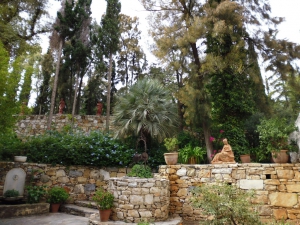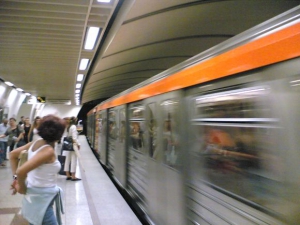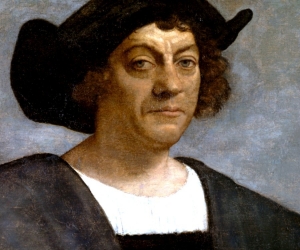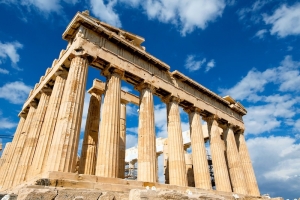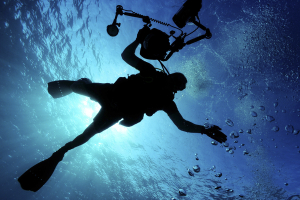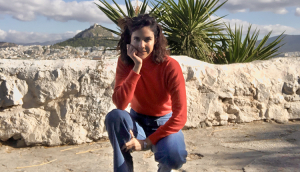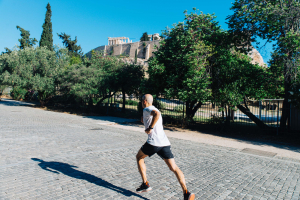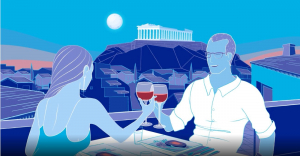XpatAthens
The Vorres Museum - A Garden Paradise
No More Free Public Transport In Athens
Christopher Columbus - A Woolworker From Genoa Or Byzantine Prince From Chios?
Most of what we know about Columbus is conjecture and much of his history was written by people who never knew him or had reasons of their own for rewriting or presenting as truth something that was just a theory. The story of his being the son of a woolworker from Genoa for example only came from the fact that there was someone named Columbus from Genoa who was a wool worker and is a legend attributed to Peter Martyr de Anghiera. Go to Genoa and you will see that there are monuments and a show of pride in it being the birthplace of Columbus.
Columbus' signature "Xro-Ferens" Christophoros is Greek-Latin or Byzantine.
Columbus spelled Chios with a Greek 'X'.
Columbus named Cape Maysi in Cuba using Greek words, Alpha and Omega.
The Colombo family of Genoa were illiterate and the Genovese Christophoro was a woolweaver. For this person to acquire the learning, experience and spirituality that Columbus had that could convince a foreign king and queen to entrust a small navy and a fortune to him doesn't seem probable. Maybe in twentieth century America a poor son of a common garment worker can grow up to become president but in the Europe of the 15th century it is unlikely he could make Captain, much less Admiral in command of a fleet. It is more likely that for Columbus to have received an audience with a king and queen he would have to be royal himself or have some pretty good connections.
Columbus' son Ferdinand wrote that his ancestors have always followed the sea. Unless the Columbo family of Genoa had a long history of being ships tailors or official shearers of sea-sheep then they were not related. In fact even though they were living in Genoa at the time that Ferdinand was writing about his father, they are not mentioned. Nor are they mentioned in the Will of Columbus.
For more on this interesting topic, please visit: GreeceTravel
We've had a difficult time turning up a copy of the book online, but have found a link on Amazon UK. You may also contact the publisher: John Perikos - Kallimassia - Chios 8210 - Greece.
International Tourism Sees Strongest Half-Year Results Since 2010
Arrivals growth in this period was fuelled by strong outbound demand from major source markets. In particular, Canada, China, France, the Republic of Korea, Spain, the United Kingdom and the United States continued to report solid growth in outbound expenditure.
Ancient Greek Shipwreck Discovered In Excellent Condition
More than 60 shipwrecks have been discovered in the area during the thorough survey, however in late 2017 the underwater cameras settled upon an Ancient Greek ship which was remarkably intact. The ship’s shape has not been compromised despite millennia at the bottom of the sea, while its mast and rudder are still clearly visible.
"A ship, surviving intact, from the Classical world, lying in over 2km of water, is something I would never have believed possible,” said Professor Jon Adams, of the Black Sean Maritime Archaeology Project.
The anoxic (un-oxygenated) environment of the Black Sea preserves artefacts better than any other marine environment and is probably why the ship has discovered in such excellent condition. Scientists are hoping to raise funding to return to the site and hunt for the treasure that is possibly trapped inside the ship.
To read this article in full, please visit: The Telegraph
XpatAthens Welcomes Eleni Maria Georgiou As An Official Content Contributor
We are always looking to meet and connect with new content contributors. If you believe that your content would be a positive addition to XpatAthens, click here to learn more about working with us!
We are very happy to welcome Eleni Maria Georgiou
as an official XpatAthens content contributor.
Who Is Eleni Maria Georgiou?
Eleni Maria Georgiou is an independent writer and publishing professional devoted to creating books that are creative, original, and modern.
Passionate about Athens and all the city has to offer, for four exciting years, I co-managed XpatAthens. This experience inspired me to write my first book, Eleni’s GREEK PHRASE BOOK: A Beginner's Guide to Greek Culture and the Greek Language in 2018, sparking the birth of Lenacke Press. I continue to write, think about, and publish creative and original books, adding to the Lenacke Press collection.
In addition, since 2004, I have been running fixyourenglish.com, a business that provides Editing, Proofreading, and Translation services.
I currently live in Athens, Greece with my husband and two kids. I am fluent in both English and Greek and interested in learning more languages. I like organizing and attending community group events, reading, listening to podcasts and audiobooks, writing, lifting weights, and going hiking.
Urban Culture Enthusiast – Athens Corona Nomads Series
This is Athens asked some second wave “corona nomads” to tell us in their own words how Athens has given them the personal and professional lift they were craving and why life is so much sweeter in the Greek capital, even in lockdown.
Chasing A Bright Urban Culture
Letizia Sebregondi, 36, Italian
Digital Wine Consultant
I was in Athens for two months last summer, staying in Mets, near the Kallimarmaro Stadium, and loved it so much. I went back to Milan a bit sad and spent the next month or so wondering, “Should I go back?”. One day, I woke up and said, “I’m going!”. I returned in late October, two weeks before the second lockdown, and plan to stay until July. Then I’ll travel around the Peloponnese and the islands.
I’ve lived abroad a lot: Brazil, the United States, France. What I find amazing about Athens is that it’s an urban city but you can still feel a human touch. Even if it’s not always an easy city, it has a really strong identity that connects you with Greek culture. But on the other hand, there are many young people relocating from Europe, even more so now because of Covid, so there’s this feeling that things are changing. People are coming to Athens to enjoy the exciting energy here.
I come from Florence, but was based in Milan, doing digital marketing for Italian and French wines; helping to create wine clubs and collectives. I still have a lot to learn about the Greek wine scene but I do see great potential in terms of the quality of the production and opportunities for local wineries to develop their sales. I’ve been pleasantly surprised at how good Greek wines are. I’ve discovered a wonderful wine bar in the city centre that focuses exclusively on Greek wines - Heteroclito – and I tried some really good value wines from the north of Greece there, including a well-balanced Assyrtiko from Ktima Voyatsi. I can’t wait to go back there when quarantine is over.

Milan is probably the most European city in Italy, but it’s somehow too classic; a little too buttoned up, compared to Athens. Athens to me has a young and vibrant spirit, with a laid back quality of life - like maybe Lisbon ten years ago. I’m not saying that everyone here can afford everything, but compared to many other cities in Europe, the urban culture feels fresh and the quality of life is amazing.
So far, the experience of remote-working in Athens has been easy. Athens is an open-hearted city. I made some good friends during the summer: foreign girls like me who all share the same love and appetite for the city. This has helped me feel at home. Every Friday, I go to the farmer’s markets in Koukaki, next to my favourite bakery ever, Mama Psomi in Zaharitsa Street, for their amazing hand-made pies. At the markets, I pick up delicious local honey and have become friends with the fishmongers and the ladies who sell the lovely lemons and capers that I like to cook with. I’ve even managed to get to the seaside a few times during lockdown by walking up through Neos Kosmos to Paleo Faliro.
There’s so much more light in my working day here than in Milan. My apartment in Koukaki has a small balcony with a spectacular view of the Acropolis and gets the sun most of the day. I take my laptop out there to work and enjoy the 360 degree view of the city and the seaside. It’s a luxury that makes me feel so happy every day.
To read more, please visit This is Athens
Whether you've just arrived in town – or have been here for years – Athens always has new secrets to share!
This is Athens is the official guide to this captivating city of ancient energies and booming urban culture. Compiled by a team of specialist local writers, This is Athens brings you an authentic and intimate portrait of a living Athens beyond the guidebooks – along with daily curated listings of all the best events and great weekend inspiration all-year round. From must-know neighbourhoods and emerging art hubs, to gourmet hotspots, cool shopping and the buzziest bars, This is Athens will help you to get the most out of living in Athens!
Thank you This is Athens for your contribution as an XpatAthens Partner.
A Runner’s Guide To Athens
Granted, drivers can be impatient at stop signs and the occasional pothole remains (though plans are afoot to repave half the city’s roads within the next few years), but Athens is much more runner-friendly nowadays, and the increasing number of Athenians lacing up regularly is proof.
The 5K Ultimate Athens Route
Let’s start on the pedestrian paved road in front of the Acropolis Museum. Dionysiou Areopagitou, as the walkway is called, is one of Europe’s most beautiful avenues, and meanders halfway around the Acropolis Hill.
For the first few hundred meters, run towards Philopappou Hill, with the Acropolis towering above you, on your right. After about half a kilometer, the road will begin to crest downhill towards the attractive Thissio neighborhood. In full tourist season, this popular pocket can be hot and crowded. If so, head for pine-clad Philopappou instead.
After another few hundred meters, you’ll reach the old Thissio train station from where you can make out the Temple of Hephaestus (we locals call it Theseus) amid the trees on your right. It’s time to turn right onto Adrianou Street and weave your way into historic Monastiraki, with its tourist shops, antique flea markets, souvlaki joints, and agreeable hustle and bustle.
Continue up Areos Street, then turn left into Dexippou Street, left again into Adrianou, and into Aiolou Street, first weaving around lower Plaka, and then moving uptown towards Syntagma Square.
At the 2.5 kilometers halfway point, you’ll turn right into the busy pedestrian artery of Ermou Street and run uphill past the big international and Greek stores until you reach Syntagma Square.
Cross Syntagma Square and turn left at the Hellenic Parliament which dominates the square. Run up Vasilissis Sofias Avenue, with the National Garden on your right.
At kilometer 3.6, turn right into Irodou Attikou Street and run downhill: along the way, you will pass the Evzones’ boxes where they stand guard. You’ll also see the Maximos Mansion, the seat of the prime minister, and the Presidential Palace. Be sure to keep the National Garden on your right always.
We suggest you continue running around the Zappeion cluster to clock some more city landmarks: you’ll whip past the Fokianos vintage gymnasium, the Zappeion Hall, and the Ethnikos Tennis Club as you move along the newly pedestrianized Vasilissis Olgas Avenue, back towards the Acropolis.
At 5 kilometers from your start, you will reach the Temple of Olympian Zeus and the Gates of Hadrian, the most philhellene of Roman emperors. Across the street, Dionysiou Areopagitou beckons, and a couple of hundred meters further along, the Acropolis museum, where you began.
To read this article in full and discover the 10K Athens Riviera Route, please visit: thisisathens.org
Photo Credit: Thomas Gravanis
Thank you This is Athens for your contribution as an XpatAthens Partner.
Greece Is ‘More Than the Eye Can See’ Says New Tourism Promo Cartoon
Screened for the first time on Thursday during the 15th Animasyros International Animation Festival on the island of Syros, the spot, titled “Greece. More than the eye can see”, presents the country as an ever-evolving sustainable destination, accessible 365 days a year.
Created in collaboration with Animasyros Productions (Zedem Media), the cartoon aims to inform travelers of all ages, from all over the world, about the multitude of alternative and thematic tourism options Greece offers.
The one-minute “Greece. More than the eye can see” cartoon showcases a significant variety of Greek landscapes and tourism activities, available to any traveler, inspired by well-known and unknown locations around the country.
The cartoon has been released in two languages – English and German – and was created with 2D animation techniques.
To read this article in full, please visit: news.gtp.gr
The Sanctuary of Dodoni
The sanctuary of Dodoni was a spiritual place in ancient Greece. It was the oldest of the Greek oracles and ancient people traveled great distances in order to consult the priests who foretold the future. Outside the temple of Zeus the priests gathered under the sacred Oak tree and listened to the sound of the leaves as they shivered in the breeze and glimpsed at the future.
People from the entire known world would make the pilgrimage in ancient times in order to consult the future-telling Oak tree and to attend cultural festivals that took place regurarly at Dodoni.
"The divine couple had their adobe in the Oak-tree, and from the rustling of its leaves and the flight of the doves (Peleiades) that nested in is branches the soothsayers of Zeus, the prophets (Selli), who slept on the ground and never washed their feet so as to be in contact with the earch and draw their oracular powers from it, interpeted the will of the god to mortals." (Dodona," by Sotirios Dakaris.)
I drove to Dodoni in a clear July morning not knowing what to expect. I drove North from Arta and within one hour or so I saw the signs for Dodona just before I reached the city of Ioannina. I turned left and followed the narrow road that snaked diligently around small and large hills until I was confronted with the majestic twin peaks of mount Tomaros (1972m and 1816m tall) at the foot of which Dodoni is nested. Although it took much longer than I anticipated, I enjoyed the drive to Dodoni enormously, and the ever-changing mountain scenery gave me the feeling that I was about to reach a special place, and I was not disappointed once there.
I entered the ruins of the sanctuary early in the morning before the hot summer sun and the hordes of tourists had a chance to ruin my pilgrimage. I walked the long dirt path from the ticket counter to the excavated site and I could see nothing that gave me the impression of an important ancient center. That is until the enormous retaining wall of the theater of Dodoni grew out of a small hill with an imposing authority that defined the rural landscape.
The limestone seats of the theater were weather beaten and nested in a respectful semicircle between the two enormous retaining walls. I entered the theater and stood alone in the middle of the orchestra pausing to comprehend the majestic scenery, and to imagine the cultural spectacle that took place in ancient times. What were the audience like? Were they restless when the play unfolded? Absorbed and motionless when the plot was climaxing? Did they remain frozen, afraid to make a sound that would disturb the illusionary space of the tragedy? What would they think of me, staring at them with camera at hand and Nike shoes at my feet?
To read more, please visit greeklandscapes.com


